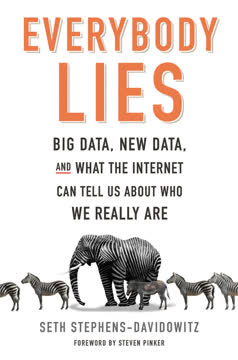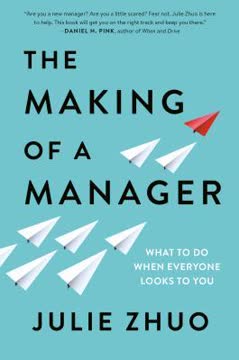Key Takeaways
1. Competition for the future requires foresight and strategic architecture
Industry foresight is based on deep insights into the trends in technology, demographics, regulation, and lifestyles that can be harnessed to rewrite industry rules and create new competitive space.
Foresight is essential. Companies must develop a clear vision of future opportunities and challenges to compete effectively. This involves analyzing trends in technology, demographics, regulations, and lifestyles to identify potential shifts in industry dynamics.
Strategic architecture guides action. Once a company has developed foresight, it needs a plan to turn that vision into reality. This strategic architecture outlines:
- Core competencies to be developed
- New customer benefits to be offered
- Changes needed in the customer interface
Companies that excel at foresight and strategic architecture can shape their industries' future rather than merely reacting to changes. They become proactive creators of new competitive spaces rather than passive followers.
2. Core competencies are gateways to future opportunities
Core competencies are the gateways to future opportunities. Leadership in a core competence represents a potentiality that is released when imaginative new ways of exploiting that core competence are envisioned.
Identify and nurture core competencies. These are unique combinations of skills and technologies that allow a company to deliver distinctive value to customers. Examples include:
- Sony's miniaturization expertise
- Honda's engine design and manufacturing prowess
- 3M's innovation in adhesives and coatings
Leverage competencies across markets. Core competencies often have applications beyond current product lines. Companies should actively seek new ways to apply their core competencies to create value in diverse markets.
Invest in future-oriented competencies. Building world-class competencies takes time, often 5-10 years or more. Companies must invest in developing competencies that will be crucial for future opportunities, even if their immediate applications aren't clear.
3. Stretch goals and resource leverage drive innovation
Strategic intent implies a significant stretch for the organization. Current capabilities and resources are manifestly insufficient to the task.
Set ambitious goals. Strategic intent should create a substantial gap between a company's current resources and its aspirations. This "stretch" motivates creativity and innovation as the organization strives to close the gap.
Maximize resource leverage. To achieve stretch goals with limited resources, companies must find ways to do more with less. This involves:
- Concentrating resources on key strategic goals
- Accumulating resources more efficiently
- Complementing one resource with another
- Conserving resources wherever possible
- Rapidly recovering resources
Resource leverage allows companies to pursue ambitious goals without relying solely on having more resources than competitors. It's about using resources more creatively and efficiently to create competitive advantage.
4. Successful companies compete for influence and shape migration paths
Competition to shape migration paths is, like competition for intellectual leadership, premarket or extramarket competition in that there is little or no direct, product-to-product rivalry between firms.
Compete for influence. In emerging industries or during periods of significant change, companies should focus on shaping the industry's future structure. This involves:
- Building and managing coalitions
- Developing critical core competencies
- Accumulating market learning
- Establishing global brand presence
Manage migration paths. Companies need to actively shape the evolution of their industry from its current state to the envisioned future. This includes:
- Influencing technology standards
- Shaping customer expectations
- Developing necessary infrastructure
- Cultivating complementary products or services
By competing for influence and managing migration paths, companies can create favorable conditions for their future success, rather than simply reacting to a predetermined industry structure.
5. Expeditionary marketing accelerates learning and market penetration
To learn faster, a company must maximize its times at bat, rather than sit on the sidelines waiting for the perfect conditions for a home run attempt.
Embrace rapid market experimentation. Instead of waiting for perfect market conditions or fully developed products, companies should launch a series of low-cost, fast-paced market incursions. This approach:
- Accelerates learning about customer needs and preferences
- Allows quick adjustments to product offerings
- Helps identify the most promising market segments
Reduce iteration time and cost. To make expeditionary marketing effective, companies must:
- Minimize the time between product iterations
- Lower the cost of each market experiment
- Develop systems for quickly incorporating learnings
Balance risk and learning. While expeditionary marketing involves taking risks, it's about calculated risks that maximize learning. The goal is to fail fast, fail cheap, and learn quickly to find the right product-market fit.
6. Global preemption secures long-term competitive advantage
Although being first to market is important, the real returns go to companies that are first to global markets.
Develop global capabilities. To preempt competitors worldwide, companies need:
- Strong worldwide distribution presence
- Ability to quickly roll out products globally
- Capacity to adapt products to local markets
Secure critical markets early. Companies should prioritize establishing a presence in:
- Large markets that offer scale economies
- Fast-growing markets with future potential
- Markets that are competitors' home turf
Build global scale rapidly. The ability to quickly achieve global scale offers several advantages:
- Faster amortization of development costs
- Establishment of global standards
- Preemption of key distribution channels
Global preemption allows companies to capture a larger share of the total value created by their innovations and make it harder for competitors to catch up.
7. Banner brands create customer predisposition and enable global reach
A trusted brand is a "warrant" to customers that the new product or service will perform to a high standard.
Develop strong banner brands. These overarching brands span multiple product categories and create a predisposition among customers to try new offerings. Benefits include:
- Reduced marketing costs for new products
- Increased customer trust and loyalty
- Ability to enter new markets more easily
Leverage brand across categories. Banner brands allow companies to:
- Transfer goodwill from one product to another
- Enter new markets with instant credibility
- Amortize brand-building investments across multiple products
Balance global consistency and local relevance. Effective banner brands maintain a consistent core identity while adapting to local market needs and preferences.
8. Organizational transformation must align with industry transformation
Only when restructuring and reengineering fail to halt corporate decline do most companies consider the need to regenerate their strategy and reinvent their industry.
Proactively transform. Companies should not wait for a crisis to reinvent themselves. Instead, they should:
- Continuously reassess their industry's future
- Identify necessary competencies for future success
- Align organizational structure with future opportunities
Balance short-term and long-term focus. Transformation efforts should address:
- Immediate operational improvements (restructuring, reengineering)
- Medium-term capability building
- Long-term strategic repositioning
Foster a culture of continuous renewal. Successful companies embed the capacity for ongoing transformation into their organizational DNA, allowing them to stay ahead of industry changes rather than reacting to them.
Last updated:
FAQ
What's Competing for the Future about?
- Future Strategy Focus: The book emphasizes the need for companies to actively shape their futures rather than just reacting to market changes. It advocates for a proactive approach to strategy that surpasses incremental improvements.
- Core Competence Perspective: Introduces the concept of core competencies, which are unique strengths that allow a company to create value and differentiate itself in the market.
- Industry Transformation: Discusses how industries are constantly evolving and the necessity for companies to adapt to maintain competitiveness, highlighting the importance of foresight in anticipating future trends.
Why should I read Competing for the Future by Gary Hamel?
- Innovative Strategic Insights: Offers a fresh perspective on strategy, challenging traditional views focused solely on operational efficiency and encouraging creative thinking for future success.
- Real-World Examples: Utilizes numerous case studies from various industries to illustrate successful strategy transformations, providing practical lessons for readers.
- Empowerment for All Employees: Advocates for a culture of empowerment, encouraging employees at all levels to contribute to strategic thinking and innovation, leading to a more engaged workforce.
What are the key takeaways of Competing for the Future?
- Shift from Incrementalism: Emphasizes the need for companies to move beyond incremental improvements and focus on fundamentally reinventing their competitive spaces.
- Importance of Foresight: Highlights the necessity of developing industry foresight to anticipate changes and shape the future, staying ahead of competitors.
- Strategic Architecture: Introduces strategic architecture as a framework for aligning resources and capabilities with future opportunities, aiding in navigating industry transformation.
What is the concept of "core competencies" in Competing for the Future?
- Unique Strengths: Core competencies are unique capabilities that give a company a competitive advantage, involving the collective learning and coordination of diverse skills and technologies.
- Focus on Value Creation: Companies should leverage their core competencies to create new products and services that meet customer needs, essential for long-term success.
- Dynamic Nature: Core competencies must evolve as market conditions change, requiring continuous assessment and development to remain relevant and competitive.
How does Competing for the Future define "strategic architecture"?
- Blueprint for Success: Strategic architecture is a high-level framework outlining how a company will deploy resources and capabilities to achieve its strategic intent.
- Linking Today and Tomorrow: Connects current operations with future goals, ensuring organizations are prepared to seize emerging opportunities.
- Flexibility and Adaptability: Must allow for flexibility and adaptation as new information and opportunities arise, crucial for navigating future uncertainties.
What role does foresight play in Competing for the Future?
- Anticipating Change: Essential for understanding potential industry shifts and customer needs, guiding strategic decisions.
- Building Competitive Advantage: Cultivating foresight positions organizations to capitalize on emerging trends before competitors, leading to market advantages.
- Collaborative Effort: Requires input from employees at all levels, enhancing the organization’s ability to anticipate and respond to change.
What is the definition of strategic intent in Competing for the Future?
- Ambitious Goals: Strategic intent is a clear and compelling goal guiding an organization’s actions and decisions over the long term, inspiring innovation.
- Focus on the Future: Should not be limited by current resources, encouraging organizations to envision a future that requires adaptation and growth.
- Alignment Across the Organization: Aligns efforts of all employees towards a common goal, fostering a sense of purpose and direction.
How does Competing for the Future define resource leverage?
- Maximizing Impact: Achieving more with less by creatively utilizing existing resources, encouraging innovative thinking.
- Efficiency and Effectiveness: Effective resource leverage can lead to significant competitive advantages, outperforming rivals with greater resources.
- Continuous Improvement: Advocates for a culture of continuous improvement, seeking ways to enhance resource utilization for sustained growth.
What is the relationship between stretch and leverage in Competing for the Future?
- Interconnected Concepts: Stretch involves setting ambitious goals, while leverage maximizes resource impact to achieve those goals.
- Driving Innovation: Stretch encourages innovation and creative resource utilization, crucial for closing the gap between aspirations and performance.
- Avoiding Complacency: Emphasizing both ensures organizations remain dynamic and responsive to market changes.
How can companies effectively "unlearn" according to Competing for the Future?
- Recognizing Outdated Practices: Companies must identify and acknowledge practices that are no longer relevant, requiring critical assessment.
- Creating a Culture of Curiosity: Fostering curiosity and open-mindedness helps challenge assumptions and explore new ideas.
- Engaging Employees in the Process: Involving employees at all levels encourages dialogue and collaboration, identifying areas for improvement.
What are some best practices for fostering a culture of innovation according to Competing for the Future?
- Encourage Experimentation: Create an environment where employees feel safe to experiment and take risks, leading to breakthrough ideas.
- Cross-Functional Collaboration: Foster collaboration across departments to generate diverse perspectives and ideas, enhancing creativity.
- Empower Employees: Empower employees to contribute to strategic discussions, building a culture of innovation and ownership.
What are the best quotes from Competing for the Future and what do they mean?
- “Destiny is no matter of chance. It is a matter of choice: It is not a thing to be waited for, it is a thing to be achieved.”: Emphasizes the need for companies to actively shape their futures.
- “The future belongs not to those who possess a crystal ball, but to those willing to challenge the biases and prejudices of the ‘establishment.’”: Highlights the importance of innovation and challenging the status quo.
- “To create the future, a company must unlearn at least some of its past.”: Stresses the need to let go of outdated practices to adapt and thrive.
Review Summary
Competing for the Future receives largely positive reviews, praised for its insights on strategy, innovation, and future-focused business thinking. Readers appreciate its emphasis on core competencies and long-term planning. However, some find it repetitive and focused mainly on large enterprises. The book is considered a seminal work in management literature, though opinions vary on its practical applicability. While some hail it as groundbreaking, others view it as common sense ideas stretched into a full book. Overall, it remains influential and thought-provoking for many business readers.
Similar Books










Download PDF
Download EPUB
.epub digital book format is ideal for reading ebooks on phones, tablets, and e-readers.






